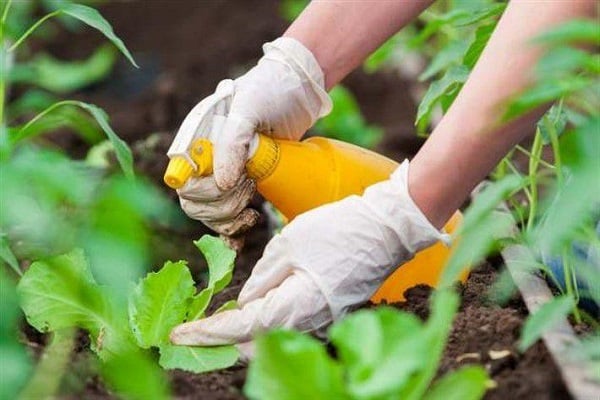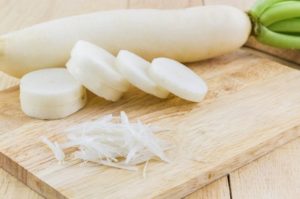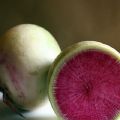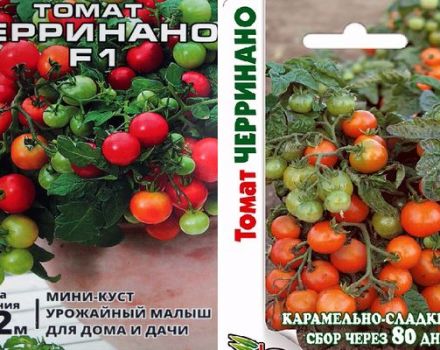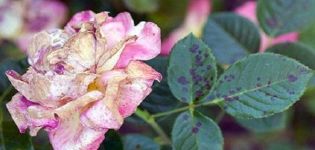Description of pests of radish (radish) and the fight against them
Every gardener growing a crop on the site met with radish pests. In nature, there are enough people who want to feast on the juicy roots of insects.
Often the gardener does not pay attention to the condition of the plants. Damaged tops - you think, enough for everyone. Some adhere to the rule: plant enough to be enough for yourself, friends and enemies.
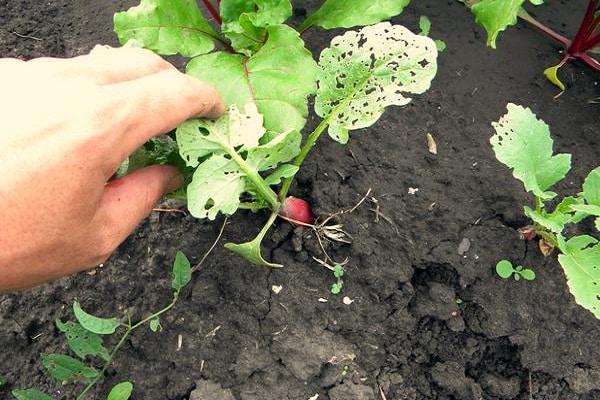
Sometimes there are too many of the latter. By the time of ripening, there is nothing to remove: the radish is small, pitted, tough. Who's guilty? Pests!
But an experienced gardener does not miss a single detail. He inspects the plantings regularly. It takes effect immediately if necessary. And the harvest pleases: the roots are smooth, juicy. And there are many of them: there is something to share with friends.
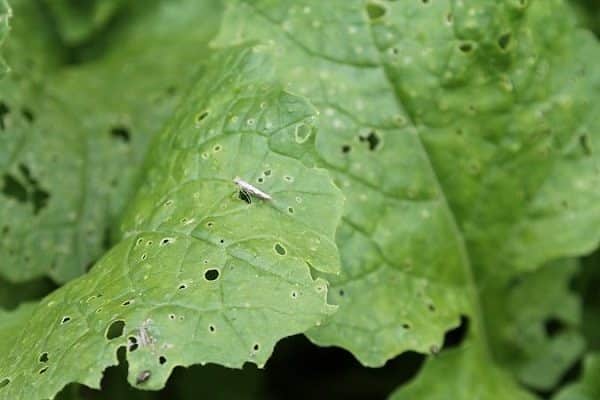
Common signs of pest damage to radish
The gardener should inspect the plantings during the entire period of ripening of the root crop. It is recommended to be alert when:
- damage to the growth point on young plants;
- perforated leaves;
- oppression of seedlings;
- slow development and growth of tops;
- damage to the protruding part of root crops.

Even in isolated cases, it is necessary to identify the pest and carry out work to protect the culture.
The main pests of radish and how to deal with them
The radish belongs to the Cruciferous family. She has common pests with cabbage, turnips, rutabagas. When related crops are affected, attention should be paid to the state of the crop planting.
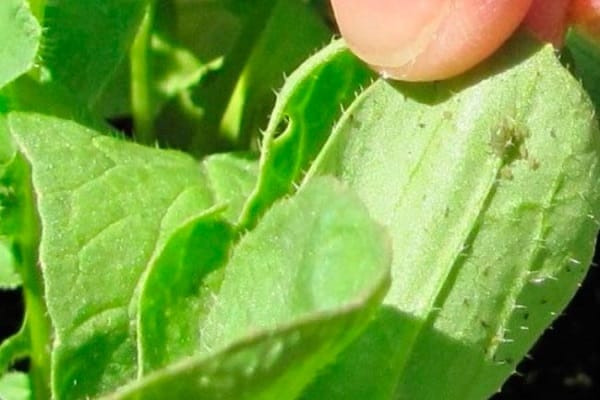
Cruciferous flea
A very dangerous pest. It is able to destroy seedlings before real leaves grow back.
This is a bouncing bug. It hibernates as adults under uncleared plant debris. When warm weather comes, it becomes active. Before sowing cultivated plants, it lives on wild representatives of the Cruciferous family. After sprouting of radish, turnip, radish feeds on young leaves.
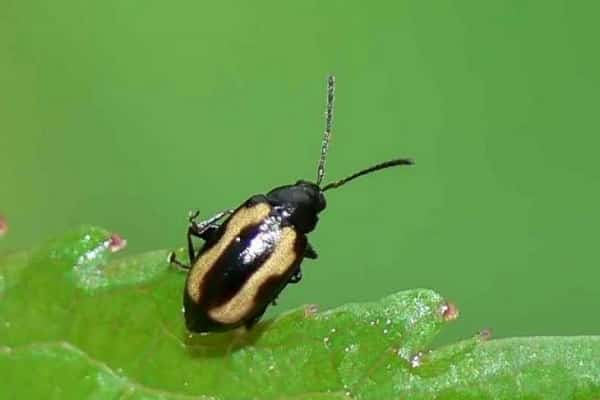
In delicate plants gnaws through holes. On the harder ones, it makes indentations. Period of activity: from morning to 1 pm and from 4 pm to 6 pm Hot weather encourages reproduction.
The flea lays eggs in the ground. The larvae live on young roots. They also feed on them. Landings disappear.
For prevention, it is recommended:
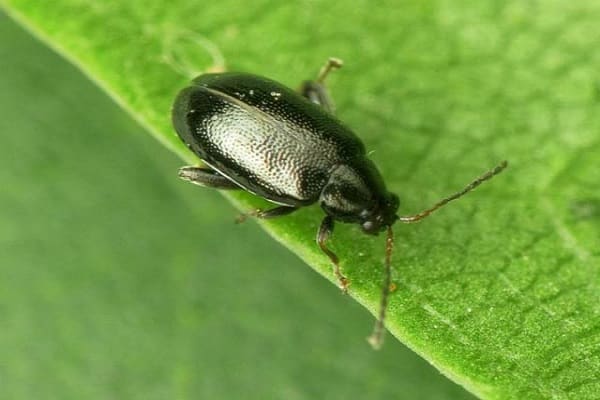
- remove plant residues;
- dig deep into the ground in the fall;
- apply mineral fertilizers to the soil;
- observe crop rotation;
- fight weeds;
- apply sealing planting of protective plants.
Gardeners dust the ridges with ash and tobacco dust. In difficult cases, it is recommended to use insecticides.
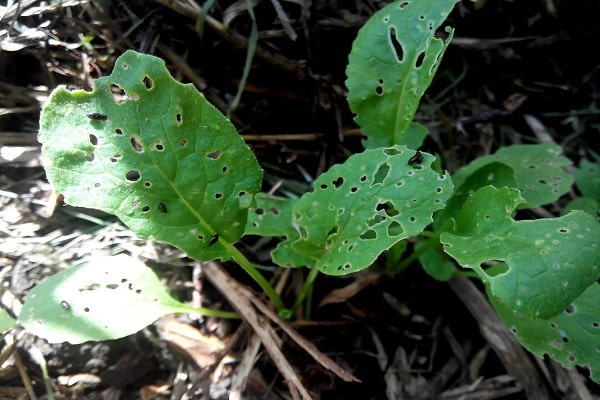
White butterfly caterpillars
This insect is familiar to every adult. Children and townspeople are touched by him. The butterfly itself is not harmful to the radish: it feeds on the nectar of flowers (alfalfa, dandelion, clover).
But she lays her eggs on the tops. From them, voracious caterpillars develop, which feed on leaves. In advanced cases, they destroy the radish tops completely. The root crop stops developing.
The gardener should regularly inspect the plantings. Pay attention to the back of the leaves. Dispose of egg and caterpillar clutches immediately.
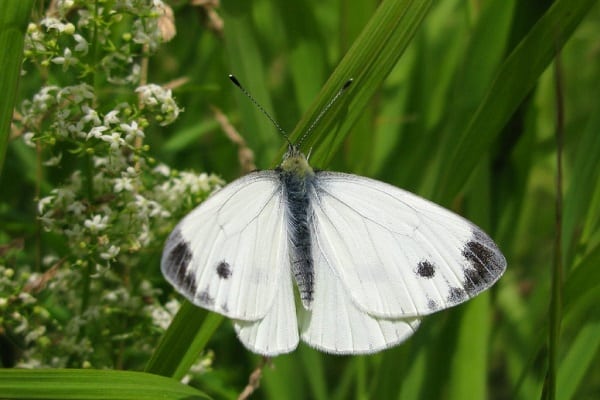
It is recommended to combine mechanical methods of protection with the treatment of plantings with insecticides (according to the instructions).
There are folk methods of protecting plants from whites. Sticks with halves of eggshells are stuck along the perimeter of the ridge. The butterfly does not like competition and flies to lay its eggs elsewhere.
Some gardeners thickly sprinkle the plantings with sifted furnace ash. Belyaka is clean. Will not multiply on dirty leaves. After rain and wind, the protection is renewed.
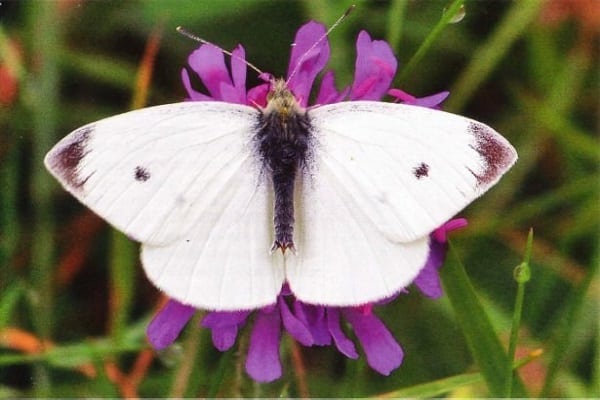
Spring cabbage fly
Refers to the type of flower flies. Mass years begins from the moment the bird cherry and cherry blossom, ends after the lilac blooms.
The fly itself feeds on nectar. She pollinates the plants. But its larvae harm gardeners. The fly lays its eggs in the soil under planting radish... The hatched larvae gnaw tender root crops, build passages. Outwardly, the radish looks depressed, the tops begin to wither.
At the first signs of damage to the plantings by a flower fly, it is necessary to start a fight. Damaged roots should be dug up and burned. Treat the soil with an insecticide.

Prevention gives excellent results. Weeds must be removed from the site. Protective measures:
- It is recommended to plant plants with a pungent aroma around the perimeter: marigolds, celery. They will scare away the fly.
- The ridges should be mulched with coarse wood chips or covered with dark non-woven material: the fly has nowhere to lay eggs.
- Stretch a net with fine meshes over the landings: the fly will not overcome the obstacle.
Some gardeners thickly sprinkle the beds with stove ash: this prevents the pest from laying eggs.
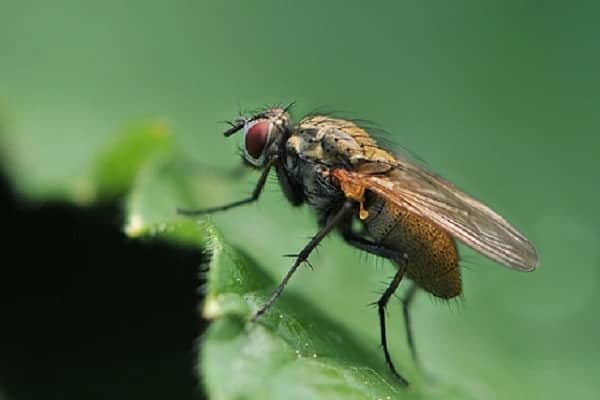
Cruciferous bug
The cabbage bug hibernates under plant debris. At the onset of heat, it flies out and lives on weeds of cruciferous plants. After the emergence of cultural moves to them.
The female lays eggs on the back of the leaf. The larvae feed on the juice of the tops. Small dots are visible in the light, they turn into spots. The leaf dies off, the plant weakens.
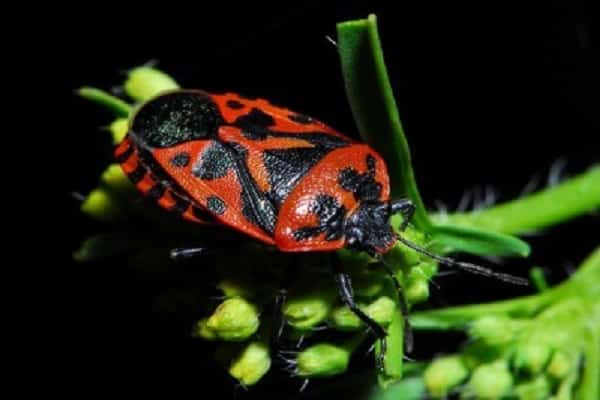
Insecticides are used to combat the pest. Prevention gives excellent results: the destruction of weeds, digging the soil before winter.
Some gardeners attract the cabbage bug to the site: the variegated fly phasia and the egg-eating trisolcus... They naturally reduce the pest population.
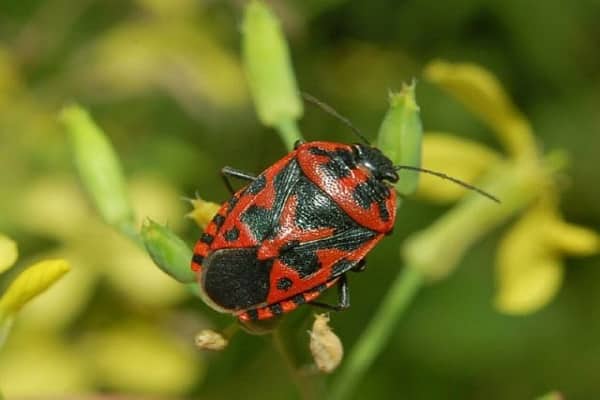
Cabbage moth
This is an inconspicuous beige butterfly. She feeds on nectar. But its caterpillars are capable of destroying the radish harvest.
As soon as the pest begins to flutter over the ridges, the fight should begin. It is recommended to inspect the back of the leaves and the middle of the rosette. Caterpillars must be collected and destroyed, eggs - washed off with a solution of green soap. In case of severe lesions, the planting of the radish should be treated with insecticides.
Some gardeners reduce the pest population using traps. A long-drying substance (pine resin, glue, grease) is applied to a piece of yellow cardboard or plastic. Butterflies stick to the composition. Insect traps are destroyed and replaced with new ones. This method helps to identify other winged pests of the radish..
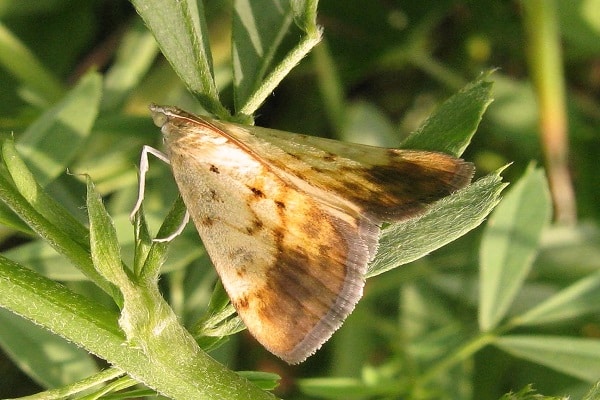
Cabbage moth
It is a night pest. The butterfly is painted dirty gray. She lays on the underside of the egg.Young caterpillars make holes in the leaves of the radish, while the stronger ones gnaw right through the bot. Then the caterpillars go underground to winter.
Preventive measures will help get rid of the pest. You should dig deep into the soil, remove weeds, observe crop rotation and neighborhood rules.
Some gardeners, to scare away a butterfly, lay out pieces of synthetic material soaked in kerosene or tar among the plantings. Insecticides should be used with caution for early radish varieties.
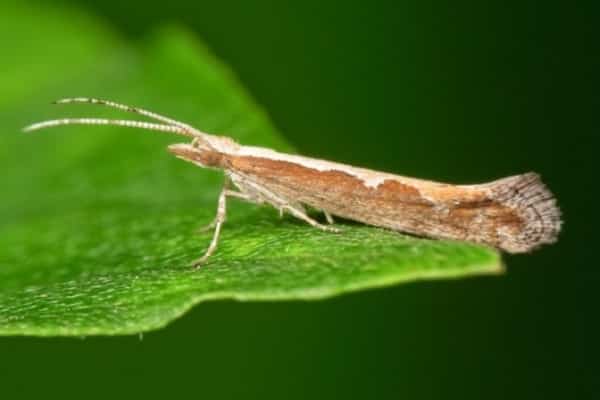
Rapeseed sawfly
The insect's ovipositor is similar to a serrated saw. With this, the female pierces the leaves on the underside and lays eggs. The caterpillars hatch. They eat the tops. After them, veins remain from the leaves.
Most active in warm dry weather. Precipitation and cold snap are destructive for them. The caterpillar wait for a short rain on the underside of the leaves.

Agronomists recommend creating plots with cruciferous bait plants. The pests move to it. The grass is mowed and burned.
The rider wasp is the sawfly's natural enemy. She lays eggs in the body of the caterpillar. Beneficial insects should be attracted to the site.
In rainy weather, the caterpillars must be collected and destroyed. In case of large populations of the pest, it is recommended to use insecticides.
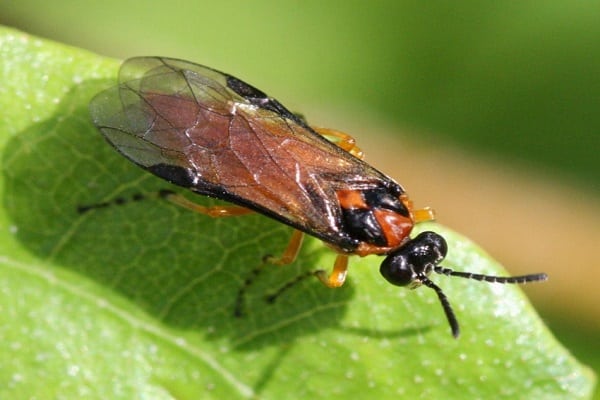
Rape flower beetle
A shiny blue-green beetle. Winters in the ground. When the soil warms up to 10 degrees Celsius, it comes to the surface.
Active from May to the end of June. Eats out the buds from the inside. Prefers rapeseed, but damages any cruciferous plants (and radishes too). Able to destroy 70% of the crop. At the first signs of planting, it is recommended to treat with an insecticide.
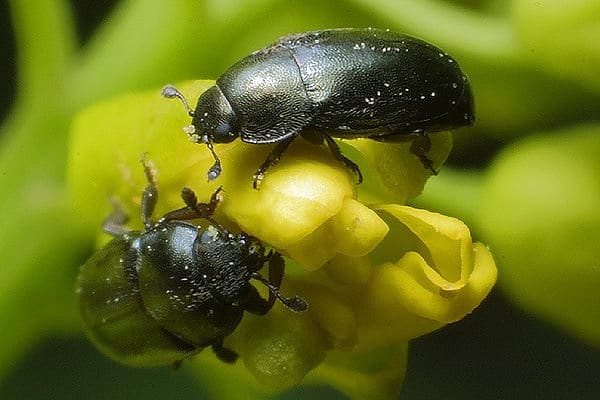
Slugs
They damage tops and parts of root crops protruding above the soil surface. They eat at night. During the day they hide under the boards, plant debris.
To protect the plantings, it is recommended to collect and destroy pests during the day. A thick layer of crushed eggshells or lime should be poured around the perimeter. This prevents the molluscs from crawling towards the plants.

Aphid
It parasitizes on tender, young leaves of radish. Sucks out juices and weakens plants.
The insect is passive. It is carried by garden ants to planting radishes. Aphids give off sweet juice, and ants like it.

To combat the pest, it is recommended to destroy anthills. A good result is obtained by treatment with the drug "Muratsid".
Aphids should be washed off the leaves with a green soap solution. To attract ladybirds, marigolds, calendula, chamomile are planted next to the radish ridges. Spraying with infusions of tobacco or orange peels will help scare off aphids.
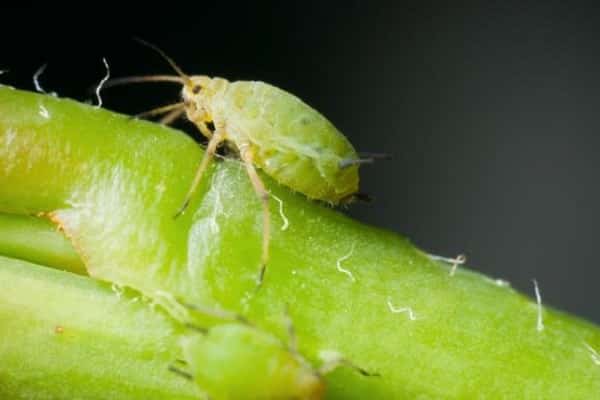
Babanukha
A shiny green bug. Spends winter in the upper layers of the soil, under manure, plant heaps. When warm weather comes, climbs up.
Gnaws leaves. The plant weakens and stops developing. Additional harm: transfers fungal and bacterial diseases to healthy plants.
Gardeners are fighting babanukha in different ways:

- harvested by hand;
- try not to miss the date of planting the radish;
- spray the ridges with insecticides.
To reduce the risk of pest infestation, crop rotation of vegetables should be observed and plant residues should be removed.
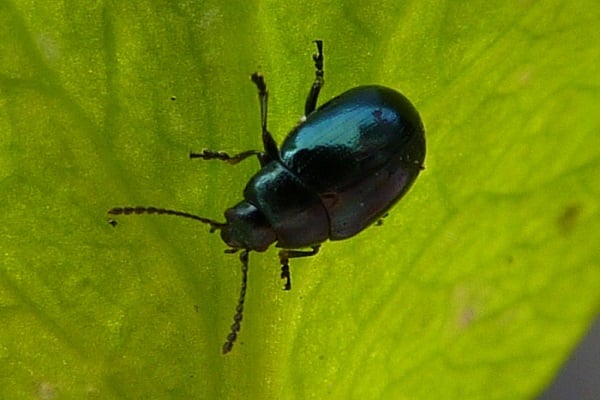
Preventive methods of protection
Pest control takes a long time. The gardener spends energy on spraying and manual collection of insects. Prevention is much more effective. Required:
- free the site from weeds;
- attract beneficial insects;
- observe the crop rotation of vegetable crops;
- plant nearby friendly plants;
- observe sowing dates;
- apply mineral fertilizers.
It is recommended to follow the agrotechnology of growing radishes: strong, healthy plants are less damaged by pests.
